 |
|
|
History
of the United States > Revolutionary Period and New Nation |
|
Although some believe that the history of the American Revolution began long before the first shots were fired in 1775, England and America did not begin an overt parting of the ways until 1763, more than a century and a half after the founding of the first permanent settlement at Jamestown, Virginia. In 1763, the end of the Seven Years' War and the French and Indian War left England in control of Canada and all of North America east of the Mississippi. The colonies long accustomed to a large measure of independence, were now demanding more freedom. They had grown vastly in economic strength and cultural attainment, and virtually all had long years of self-government behind them. The British government, which needed more money to support its growing empire, started a new financial policy. Money for the colonies' defense was to be extracted from the colonists through a stronger central administration. This would come at the expense of colonial self-government. The colonists resisted the new taxes and regulations imposed by England, such as the Sugar Act, the Stamp Act, the Townshend Act or the Coercive Act. They insisted that they could be taxed only by their own colonial assemblies, and the colonists rallied behind the slogan "no taxation without representation." The conflict escalated and King George III issued a proclamation on August 23, 1775, declaring the colonies to be in a state of rebellion. On July 4, 1776, the Continental Congress adopted a Declaration of Independence. Armed conflict between America and England lasted until 1783. Known as the Treaty of Paris, the peace settlement acknowledged the independence, freedom and sovereignty of the 13 former colonies, now states, to which Great Britain granted the territory west to the Mississippi River, north to Canada and south to Florida, which was returned to Spain. The 13 colonies were now "free and united independent states" - but not yet one united nation. The success of the Revolution gave Americans the opportunity to give legal form to their ideals as expressed in the Declaration of Independence, and to remedy some of their grievances through state constitutions. As early as May 10, 1776, Congress had passed a resolution advising the colonies to form new governments. On a national level, the "Articles of Confederation and Perpetual Union" produced by John Dickinson in 1776, were adopted by the Continental Congress in November 1777, and they went into effect in 1781. The governmental framework established by the Articles had many weaknesses, for example the national government lacked the authority to set up tariffs, to regulate commerce and to levy taxes. It lacked sole control of international relations: a number of states had begun their own negotiations with foreign countries. Nine states had organized their own armies, and several had their own navies. In May 1787, a convention met in Philadelphia to draft a new Constitution which established a stronger federal government empowered to collect taxes, conduct diplomacy, maintain armed forces and regulate foreign trade and commerce among the states. The Constitution divides the government into three branches, each separate and distinct fom one another. The powers given to each are delicately balanced by the powers of the other two; and each branch serves as a check on potential excesses of the others. Within two years of its adoption, ten amendments, collectively known as the Bill of Rights, were added to the Constitution. See also: |
||
| Texts
are abridged from U.S. State Department IIP
publications and other U.S. government materials. |
||
| What kind of information materials are available?
CD: These documents are available in fulltext format on the About the USA CD-ROM. Teachers: Request a copy for classroom use. L: Selected documents are available in German as well as other languages, including Arabic, Chinese, French, Spanish, Persian and Turkish. |
DISCLAIMER
Any reference obtained from this server to a specific commercial product, process, or service does not constitute or imply an endorsement by the United States Government of the product, process, or service, or its producer or provider. The views and opinions expressed in any referenced document do not necessarily state or reflect those of the United States Government. |
 U.S. Diplomatic Mission to Germany /Public Affairs/ Information Resource Centers Updated: December 2008 |
